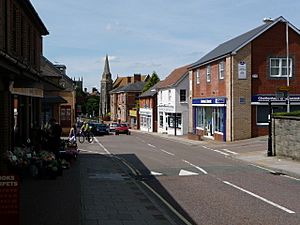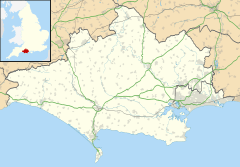Gillingham, Dorset facts for kids
Quick facts for kids Gillingham |
|
|---|---|
 High Street, Gillingham |
|
| Population | 11,756 (2011) |
| OS grid reference | ST805265 |
| • London | 98.4 mi (158.4 km) ENE |
| Civil parish |
|
| Unitary authority |
|
| Ceremonial county | |
| Region | |
| Country | England |
| Sovereign state | United Kingdom |
| Post town | GILLINGHAM |
| Postcode district | SP8 |
| Dialling code | 01747 |
| Police | Dorset |
| Fire | Dorset |
| Ambulance | South Western |
| EU Parliament | South West England |
| UK Parliament |
|
Gillingham (pronounced GHIL-ing-əm) is a town in Dorset, England. It is located in the Blackmore Vale area. Gillingham is about 4 miles (6.4 km) south of the A303 road. It is also about 5 miles (8 km) northwest of Shaftesbury. This makes it the most northern town in Dorset.
In 2011, about 11,756 people lived in Gillingham. As the town has grown, nearby small villages like Peacemarsh, Bay, and Wyke have become part of it.
It's important to know how to say Gillingham. The "G" at the start is a hard sound, like in "goat". This is different from Gillingham in Kent, where the "G" sounds like a "J".
Contents
History of Gillingham

Gillingham has a very long history! People lived here even in the Stone Age. We know this because there is a Stone Age burial mound (called a barrow) in the town. There is also proof that Romans lived here in the 2nd and 3rd centuries.
However, the town as we know it was started by the Saxons. The local church, St Mary the Virgin, has a Saxon cross shaft from the 9th century. This shows how old the Christian community is here.
How Gillingham Got Its Name
The name Gillingham was first used in a Saxon document from the 10th century. It also appeared in records from 1016. This was when a battle happened here between King Edmund Ironside and the Danish King Cnut.
In the Domesday Book of 1086, the town was called Gelingeham. Over time, the spelling changed to Gellingeham (1130) and Gyllingeham (1152). The name comes from an old personal name, Gylla. It means "the home of Gylla's family or followers".
Important Events in Gillingham's Past
Sadly, in 1348, half of Gillingham's 2,000 residents died from the Black Death. This was a terrible disease that spread across Europe.
In the Middle Ages, Gillingham was home to a royal hunting lodge. Kings like Henry I, Henry II, King John, and Henry III visited it. There was a special royal forest nearby. This forest was kept just for the king's deer to hunt. The lodge eventually fell apart and was destroyed in 1369 by King Edward III.
Gillingham became an important farming town. In 1516, it got the first grammar school in Dorset. This was a big deal for education! Later, in 1769, a silk mill opened here. Many buildings in the town today are from the Tudor period.
Gillingham in Art and Industry
In the 1820s, the famous artist John Constable stayed in Gillingham. He loved the beautiful countryside and drew many sketches and paintings of the area. One of his paintings, Gillingham Bridge, is now in the Tate Gallery.
The arrival of the railway in the 1850s brought new growth to Gillingham. New businesses started, like brickmaking, cheese production, and printing. By the end of the 19th century, one of the first petrol engine factories in the country was here.
During the Second World War, Gillingham's location on the railway line from London to Exeter was very important. Many people from London and other big cities were moved to safer, rural towns like Gillingham. This caused the town to grow very quickly.
Population of Gillingham
In the 2011 census, Gillingham had 5,345 homes. There were 5,107 households, and the total population was 11,756 people. A census is like a big count of everyone living in an area.
The table below shows how Gillingham's population has changed over many years:
| Census Population of Gillingham Parish 1921—2011 (except 1941) | ||||||||||||||
|---|---|---|---|---|---|---|---|---|---|---|---|---|---|---|
| Census | 1921 | 1931 | 1951 | 1961 | 1971 | 1981 | 1991 | 2001 | 2011 | |||||
| Population | 3,294 | 3,274 | 3,352 | 3,619 | 4,050 | 5,440 | 6,740 | 9,340 | 11,756 | |||||
| Source:Dorset County Council | ||||||||||||||
How Gillingham is Governed
Gillingham is split into four areas for its Town Council: Gillingham Town, Lodbourne, Milton, and Wyke. These areas help manage local services. In the 2011 census, these four areas had a total population of 9,799.
Gillingham is also part of the North Dorset area for the UK Parliament. This means people in Gillingham vote for a Member of Parliament (MP). An MP represents their area in the national government. Currently, the MP for North Dorset is Simon Hoare from the Conservative Party.
Since 2019, the Gillingham area also elects three councillors to the larger Dorset Council. This council looks after services for the whole county.
Economy and Community Life

Gillingham has good ways to travel. It is about 4 miles (6.4 km) south of the A303, which is a main road connecting London to the South West of England. The town also has its own railway station. This station is on the train line that goes from Exeter to London.
You can get to Salisbury by train in about 30 minutes, or by car in 50 minutes. A train journey to central London (Waterloo station) takes about two hours.
Gillingham has around 70 shops. It also has two business areas called Brickfields Business Park and Brickfields Industrial Estate. For education, there are 7 primary schools in the Gillingham area, with 4 of them right in the town. There is also 1 secondary school.
Events and Sports
Every August, Gillingham hosts the 'Gillingham & Shaftesbury Show'. This is a big agricultural show held on the edge of town. It's a fun event to learn about farming and local produce. The Gillingham Town Carnival is another popular event, held every October.
For sports fans, the biggest club in town is North Dorset Rugby Club. It is located at Slaughtergate, on the west side of Gillingham. The town also has a football club called Gillingham Town. They play their games at Woodwater Lane.
Gillingham has had a brass band since 1928. They often play at town events and carnivals, adding music to the community.
Media
If you live in Gillingham, you can get local news and TV shows from BBC West and ITV West Country. These signals come from the Mendip TV transmitter.
For local radio, you can listen to BBC Radio Solent and BBC Radio Somerset. Other stations include Heart West Country, Greatest Hits Radio South (which used to be Vale FM), and Alfred Radio. Alfred Radio is a community station that broadcasts from Shaftesbury.
The town also has local newspapers. These include the Gillingham News and the Dorset Echo.
See also
 In Spanish: Gillingham (Dorset) para niños
In Spanish: Gillingham (Dorset) para niños


